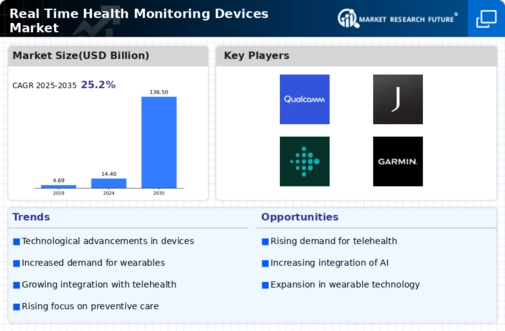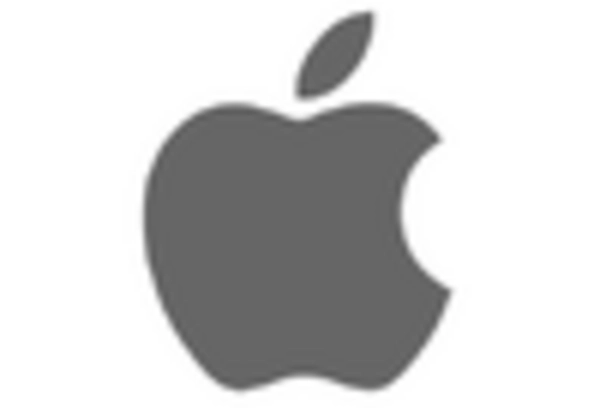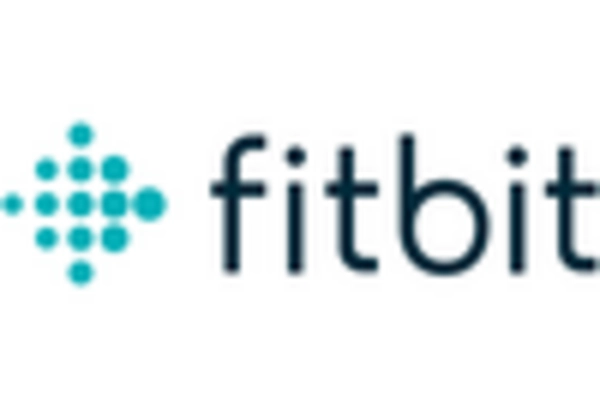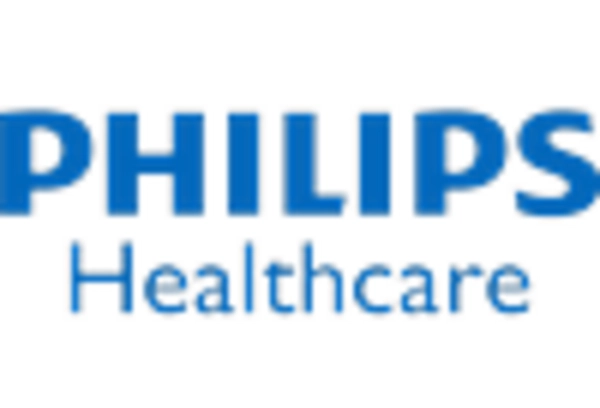-
Scope Of Study 10
-
Research Objective 10
-
Assumptions & Limitations 11
- Assumptions 11
- Limitations 11
-
Market Structure 11
-
Research Methodology
-
Primary Research 13
-
Secondary Research 13
-
Market Dynamics
-
Introduction 14
-
Drivers 15
- Increasing Use Of Smartphones And Wearable Devices Into Healthcare 15
- Cost Effectiveness And Patients’ Convenience To Use These Devices 15
- Increased Usage Of Smart Devices For Health Management 16
-
Restraints 17
- Lack Of Awareness About The Possible Applications Of Real Time Health Monitoring Devices 17
- Reluctance To Share Information Regarding The Health 17
-
Opportunities 18
- Growing Partnership Between The Companies Has Become The Entrance Gateway For New Firms 18
- Introduction Of Real Time Health Monitoring Device In Developing Economies Will Boost The Growth Of These Devices 18
-
Challenges 19
- Low Rate Of Literacy And Language Barriers In Low- And Middle-Income Countries (LMICs) Is A Big Challenge For The Real Time Health Monitoring Device Solutions 19
- Potential Risk Of Hardware Or Software Failure Will Bar The Growth Of The Market 19
-
Market Factor Analysis
-
Real Time Health Monitoring Device: Porter’s Five Force Analysis 20
- Threat From New Entrant 22
- Bargaining Power Of Supplier 22
- Threat From Substitute 22
- Bargaining Power Of Buyer 22
- Intensity Of Competitive Rivalry 23
-
Value Chain Analysis 24
- Device Manufacturers 25
- App Developers 25
- Network Providers/ Mobile Operators 25
- Healthcare Providers And Pharmaceuticals 25
- Patients 26
-
Real Time Health Monitoring Devices Market, By Type
-
Introduction 27
-
Wearable Devices 29
- Fitness Bands 30
- Head Bands 30
- Smart Watch 31
- Smart Clothing 31
- Others 32
-
Home Health Medical Devices 33
- Blood Pressure Monitors 35
- Glucometers 35
- Pulse Oximeters 36
- Other Medical Devices 36
-
Real Time Health Monitoring Devices Market, By End User
-
Introduction 37
- Hospitals 38
- Clinics 39
- Ambulatory Centers 40
- Home Settings 41
-
Global Real Time Health Monitoring Devices Market, By Region
-
Introduction 42
- North America 43
-
Real Time Health Monitoring Devices Market, By Type
-
Real Time Health Monitoring Devices Market, By End User
-
US. 47
-
Real Time Health Monitoring Devices Market, By Type
-
Real Time Health Monitoring Devices Market, By End User
-
Canada 49
-
Real Time Health Monitoring Devices Market, By Type
-
Real Time Health Monitoring Devices Market, By End User
-
Europe 51
-
Real Time Health Monitoring Devices Market, By Type
-
Real Time Health Monitoring Devices Market, By End User
-
Germany 54
-
Real Time Health Monitoring Devices Market, By Type
-
Real Time Health Monitoring Devices Market, By End User
-
France 56
-
Real Time Health Monitoring Devices Market, By Type
-
Real Time Health Monitoring Devices Market, By End User
-
UK 58
-
Real Time Health Monitoring Devices Market, By Type
-
Real Time Health Monitoring Devices Market, By End User
-
Italy 60
-
Real Time Health Monitoring Devices Market, By Type
-
Real Time Health Monitoring Devices Market, By End User
-
Spain 62
-
Real Time Health Monitoring Devices Market, By Type
-
Real Time Health Monitoring Devices Market, By End User
-
Rest Of Europe 64
-
Real Time Health Monitoring Devices Market, By Type
-
Real Time Health Monitoring Devices Market, By End User
-
Asia-Pacific 66
-
Real Time Health Monitoring Devices Market, By Type
-
Real Time Health Monitoring Devices Market, By End User
-
Japan 69
-
Real Time Health Monitoring Devices Market, By Type
-
Real Time Health Monitoring Devices Market, By End User
-
China 71
-
Real Time Health Monitoring Devices Market, By Type
-
Real Time Health Monitoring Devices Market, By End User
-
India 73
-
Real Time Health Monitoring Devices Market, By Type
-
Real Time Health Monitoring Devices Market, By End User
-
Australia 75
-
Real Time Health Monitoring Devices Market, By Type
-
Real Time Health Monitoring Devices Market, By End User
-
South Korea 77
-
Real Time Health Monitoring Devices Market, By Type
-
Real Time Health Monitoring Devices Market, By End User
-
Rest Of Asia-Pacific 79
-
Real Time Health Monitoring Devices Market, By Type
-
Real Time Health Monitoring Devices Market, By End User
-
Middle East & Africa 81
-
Real Time Health Monitoring Devices Market, By Type
-
Real Time Health Monitoring Devices Market, By End User
-
UAE 84
-
Real Time Health Monitoring Devices Market, By Type
-
Real Time Health Monitoring Devices Market, By End User
-
Africa 86
-
Real Time Health Monitoring Devices Market, By Type
-
Real Time Health Monitoring Devices Market, By End User
-
Rest Of Middle East 88
-
Real Time Health Monitoring Devices Market, By Type
-
Real Time Health Monitoring Devices Market, By End User
-
Competitive Landscape
-
Introduction 90
-
Company Profile
-
GE Healthcare 91
- Company Overview 91
- Product/Business Segment Overview 91
- Financial Overview 92
- Key Development 93
- SWOT Analysis 94
-
Qualcomm 95
- Company Overview 95
- Product/Business Segment Overview 95
- Financial Overview 95
- Key Development 96
- SWOT Analysis 97
-
Jawbone, Inc. 98
- Overview 98
- Product/Business Segment Overview 98
- Financials 98
- Key Developments 99
- SWOT Analysis 100
-
Withings SA 101
- Overview 101
- Product/Business Segment Overview 101
- Financials 101
- Key Developments 102
- SWOT Analysis 103
-
Fitbit, Inc. 104
- Overview 104
- Product/Business Segment Overview 104
- Financials 104
- Key Developments 105
- SWOT Analysis 105
-
Garmin Ltd. 106
- Overview 106
- Product/Business Segment Overview 106
- Financials 107
- Key Developments 108
- SWOT Analysis 109
-
List Of Tables
-
GLOBAL REAL TIME HEALTH MONITORING DEVICES MARKET, BY TYPE, 2020–2027 (USD MILLION) 28
-
GLOBAL REAL TIME HEALTH MONITORING DEVICES MARKET FOR WEARABLE DEVICES, BY REGION, 2020–2027 (USD MILLION) 29
-
GLOBAL REAL TIME HEALTH MONITORING DEVICE, BY WEARABLE DEVICE TYPE, 2020–2027 (USD MILLION) 32
-
GLOBAL REAL TIME HEALTH MONITORING DEVICES MARKET FOR HOME HEALTH MEDICAL DEVICES, BY REGION, 2020–2027 (USD MILLION) 33
-
GLOBAL REAL TIME HEALTH MONITORING DEVICE, BY HOME HEALTH MEDICAL DEVICES TYPE, 2020–2027 (USD MILLION) 36
-
GLOBAL REAL TIME HEALTH MONITORING DEVICE, BY END USER, 2020–2027 (USD MILLION) 38
-
GLOBAL REAL TIME HEALTH MONITORING DEVICES MARKET FOR HOSPITALS, 2020–2027 (USD MILLION) 39
-
GLOBAL REAL TIME HEALTH MONITORING DEVICES MARKET FOR CLINICS, 2020–2027 (USD MILLION) 39
-
GLOBAL REAL TIME HEALTH MONITORING DEVICES MARKET FOR AMBULATORY CENTERS, 2020–2027 (USD MILLION) 40
-
GLOBAL REAL TIME HEALTH MONITORING DEVICES MARKET FOR HOME SETTINGS, 2020–2027 (USD MILLION) 41
-
GLOBAL REAL TIME HEALTH MONITORING DEVICES MARKET, BY REGION, 2020–2027 (USD MILLION) 43
-
NORTH AMERICA REAL TIME HEALTH MONITORING DEVICES MARKET, BY COUNTRY, 2020–2027 (USD MILLION) 44
-
NORTH AMERICA REAL TIME HEALTH MONITORING DEVICES MARKET, BY TYPE, 2020–2027 (USD MILLION) 45
-
NORTH AMERICA REAL TIME HEALTH MONITORING DEVICES MARKET, BY END USER, 2020–2027 (USD MILLION) 46
-
US REAL TIME HEALTH MONITORING DEVICES MARKET, BY TYPE, 2020–2027 (USD MILLION) 47
-
US REAL TIME HEALTH MONITORING DEVICES MARKET, BY END USER, 2020–2027 (USD MILLION) 48
-
CANADA REAL TIME HEALTH MONITORING DEVICES MARKET, BY TYPE, 2020–2027 (USD MILLION) 49
-
CANADA REAL TIME HEALTH MONITORING DEVICES MARKET, BY END USER, 2020–2027 (USD MILLION) 50
-
EUROPE REAL TIME HEALTH MONITORING DEVICES MARKET, BY COUNTRY, 2020–2027 (USD MILLION) 51
-
EUROPE REAL TIME HEALTH MONITORING DEVICES MARKET, BY TYPE, 2020–2027 (USD MILLION) 52
-
EUROPE REAL TIME HEALTH MONITORING DEVICES MARKET, BY END USER, 2020–2027 (USD MILLION) 53
-
GERMANY REAL TIME HEALTH MONITORING DEVICES MARKET, BY TYPE, 2020–2027 (USD MILLION) 54
-
GERMANY REAL TIME HEALTH MONITORING DEVICES MARKET, BY END USER, 2020–2027 (USD MILLION) 55
-
FRANCE REAL TIME HEALTH MONITORING DEVICES MARKET, BY TYPE, 2020–2027 (USD MILLION) 56
-
FRANCE REAL TIME HEALTH MONITORING DEVICES MARKET, BY END USER, 2020–2027 (USD MILLION) 57
-
UK REAL TIME HEALTH MONITORING DEVICES MARKET, BY TYPE, 2020–2027 (USD MILLION) 58
-
UK REAL TIME HEALTH MONITORING DEVICES MARKET, BY END USER, 2020–2027 (USD MILLION) 59
-
ITALY REAL TIME HEALTH MONITORING DEVICES MARKET, BY TYPE, 2020–2027 (USD MILLION) 60
-
ITALY REAL TIME HEALTH MONITORING DEVICES MARKET, BY END USER, 2020–2027 (USD MILLION) 61
-
SPAIN REAL TIME HEALTH MONITORING DEVICES MARKET, BY TYPE, 2020–2027 (USD MILLION) 62
-
SPAIN REAL TIME HEALTH MONITORING DEVICES MARKET, BY END USER, 2020–2027 (USD MILLION) 63
-
REST OF EUROPE REAL TIME HEALTH MONITORING DEVICES MARKET, BY TYPE, 2020–2027 (USD MILLION) 64
-
REST OF EUROPE REAL TIME HEALTH MONITORING DEVICES MARKET, BY END USER, 2020–2027 (USD MILLION) 65
-
ASIA-PACIFIC REAL TIME HEALTH MONITORING DEVICES MARKET, BY COUNTRY, 2020–2027 (USD MILLION) 66
-
ASIA-PACIFIC REAL TIME HEALTH MONITORING DEVICES MARKET, BY TYPE, 2020–2027 (USD MILLION) 67
-
ASIA-PACIFIC REAL TIME HEALTH MONITORING DEVICES MARKET, BY END USER, 2020–2027 (USD MILLION) 68
-
JAPAN REAL TIME HEALTH MONITORING DEVICES MARKET, BY TYPE, 2020–2027 (USD MILLION) 69
-
JAPAN REAL TIME HEALTH MONITORING DEVICES MARKET, BY END USER, 2020–2027 (USD MILLION) 70
-
CHINA REAL TIME HEALTH MONITORING DEVICES MARKET, BY TYPE, 2020–2027 (USD MILLION) 71
-
CHINA REAL TIME HEALTH MONITORING DEVICES MARKET, BY END USER, 2020–2027 (USD MILLION) 72
-
INDIA REAL TIME HEALTH MONITORING DEVICES MARKET, BY TYPE, 2020–2027 (USD MILLION) 73
-
INDIA REAL TIME HEALTH MONITORING DEVICES MARKET, BY END USER, 2020–2027 (USD MILLION) 74
-
AUSTRALIA REAL TIME HEALTH MONITORING DEVICES MARKET, BY TYPE, 2020–2027 (USD MILLION) 75
-
AUSTRALIA REAL TIME HEALTH MONITORING DEVICES MARKET, BY END USER, 2020–2027 (USD MILLION) 76
-
SOUTH KOREA REAL TIME HEALTH MONITORING DEVICES MARKET, BY TYPE, 2020–2027 (USD MILLION) 77
-
SOUTH KOREA REAL TIME HEALTH MONITORING DEVICES MARKET, BY END USER, 2020–2027 (USD MILLION) 78
-
REST OF ASIA-PACIFIC REAL TIME HEALTH MONITORING DEVICES MARKET, BY TYPE, 2020–2027 (USD MILLION) 79
-
REST OF ASIA-PACIFIC REAL TIME HEALTH MONITORING DEVICES MARKET, BY END USER, 2020–2027 (USD MILLION) 80
-
MIDDLE EAST & AFRICA REAL TIME HEALTH MONITORING DEVICES MARKET, BY COUNTRY, 2020–2027 (USD MILLION) 81
-
MIDDLE EAST & AFRICA REAL TIME HEALTH MONITORING DEVICES MARKET, BY TYPE, 2020–2027 (USD MILLION) 82
-
MIDDLE EAST & AFRICA REAL TIME HEALTH MONITORING DEVICES MARKET, BY END USER, 2020–2027 (USD MILLION) 83
-
UAE REAL TIME HEALTH MONITORING DEVICES MARKET, BY TYPE, 2020–2027 (USD MILLION) 84
-
UAE REAL TIME HEALTH MONITORING DEVICES MARKET, BY END USER, 2020–2027 (USD MILLION) 85
-
AFRICA REAL TIME HEALTH MONITORING DEVICES MARKET, BY TYPE, 2020–2027 (USD MILLION) 86
-
AFRICA REAL TIME HEALTH MONITORING DEVICES MARKET, BY END USER, 2020–2027 (USD MILLION) 87
-
REST OF MIDDLE EAST REAL TIME HEALTH MONITORING DEVICES MARKET, BY TYPE, 2020–2027 (USD MILLION) 88
-
REST OF MIDDLE EAST REAL TIME HEALTH MONITORING DEVICES MARKET, BY END USER, 2020–2027 (USD MILLION) 89
-
GE HEALTHCARE: KEY DEVELOPMENT 93
-
QUALCOMM : KEY DEVELOPMENT 96
-
List Of Figures
-
GLOBAL REAL TIME HEALTH MONITORING DEVICE: MARKET STRUCTURE 11
-
RESEARCH PROCESS 12
-
REAL TIME HEALTH MONITORING DEVICES MARKET: MARKET DYNAMICS 14
-
GLOBAL REAL TIME HEALTH MONITORING DEVICE MARKET: PORTER FIVE FORCES ANALYSIS 21
-
GLOBAL REAL TIME HEALTH MONITORING DEVICE MARKET: VALUE CHAIN 24
-
GLOBAL REAL TIME HEALTH MONITORING DEVICES MARKET, BY TYPE, 2020 AND 2027 (USD MILLION) 27
-
HEALTHCARE WEARABLE DEVICES TYPES 30
-
HOME HEALTH MEDICAL DEVICES TYPES 34
-
GLOBAL REAL TIME HEALTH MONITORING DEVICE, BY END USER, 2020 AND 2027 (USD MILLION) 37
-
GLOBAL REAL TIME HEALTH MONITORING DEVICES MARKET, BY REGION, 2020 AND 2027 (USD MILLION) 43
-
GLOBAL REAL TIME HEALTH MONITORING DEVICES MARKET: COMPETITIVE LANDSCAPE 90
-
GE HEALTHCARE: RECENT FINANCIAL 92
-
GE HEALTHCARE: GEOGRAPHICAL MIX 92
-
GE HEALTHCARE: OPERATING SEGMENTS 93
-
GE HEALTHCARE 93
-
GE HEALTHCARE: SWOT ANALYSIS 94
-
QUALCOMM :RECENT FINANCIAL 95
-
QUALCOMM : GEOGRAPHICAL MIX 96
-
QUALCOMM : SWOT ANALYSIS 97
-
JAWBONE INC. : SWOT ANALYSIS 100
-
WITHINGS SA : SWOT ANALYSIS 103
-
FITBIT INC. : SWOT ANALYSIS 105
-
GARMIN LTD.: RECENT FINANCIALS 107
-
GARMIN LTD.: OPERATING SEGMENTS 107
-
GARMIN LTD.: GEOGRPAHIC MIX 108
-
GARMIN LTD. : SWOT ANALYSIS 109'









Leave a Comment